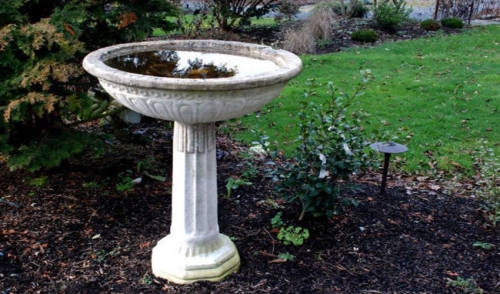{article.name}
Winterize Your Bird Baths

- Share this:
- Share on Facebook
- Pin on Pinterest
- Tweet on Twitter
Birds need liquid water to drink year-round. While they can melt snow and ice in the winter to drink, doing so takes a lot of calories and body heat, and if backyard birders provide liquid water, birds will be healthy and their winter survival rates will be higher. Providing winter water begins long before snow falls. Bird Lovers should start by winterizing their bird baths in autumn to be sure they are ready for the first freezing temperatures.
5 Fast Steps to Winterize Bird Baths
If you want to provide water to birds no matter how cold it may get, these steps can keep your bird baths ready no matter how quickly winter arrives or how severe snowstorms may be.
- Put Away Unsuitable Baths
Not all bird baths are usable in winter. Delicate baths, such as those with mosaics or other decorative accents, can easily break in winter, while heavy ice buildup can damage concrete bird baths. Very small baths will also freeze too quickly in winter and should be put away. Instead, opt for durable plastic bird baths in winter, with wide basins to accommodate many birds at a single water source.
- Position Baths for Winter Use
Bird baths can be placed in full sunlight in winter to help keep the water liquid without overworking a heater. The baths should also be convenient to a water source, either an outdoor spigot that can be used safely in winter or a porch, deck or patio where birders can easily refill the bath even in poor weather. If a heated bird bath will be used, be sure it is close to an appropriate outdoor electrical outlet.
- Clean and Sterilize the Bath
A thorough cleaning is essential in fall after a bird bath has been vigorously used by autumn birds, including passing migrants. Scrub the bath well, including the rim where birds perch, and sterilize the basin with a weak bleach solution. The cleaner the bath is in late autumn, the less frequently it may need to be cleaned throughout the winter (though some cleaning will still be necessary).
- Add a Heater
In colder areas where freezing is common, a heater must be added to a bird bath to keep the water liquid in winter. Choose an immersible heater designed for outdoor bird bath use, or opt for a fully integrated heated bird bath. Be sure the cord is protected and the outlet is suitable for winter use. These heaters will not "warm" the bath but instead just keep the water liquid, and their electricity consumption is minimal.
- Add Sticks and Stones
While birds do not typically bathe in winter, adding a few stones to the bath and a few sticks across the top of the basin will discourage any bathing and provide additional perches for thirsty birds to use. This will improve access to the bath and allow more birds to drink whenever necessary.
By winterizing your bird baths in fall, you'll be ready to provide any thirsty birds a drink no matter when the temperature falls below freezing. You'll be amazed at how many birds are willing to take advantage of such an easy water source, bringing plenty of bird watching excitement to the backyard all winter long.



Comments